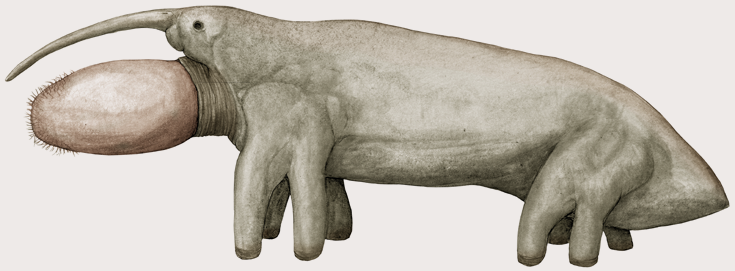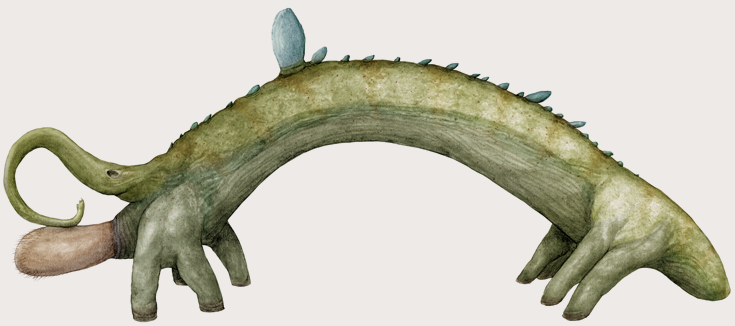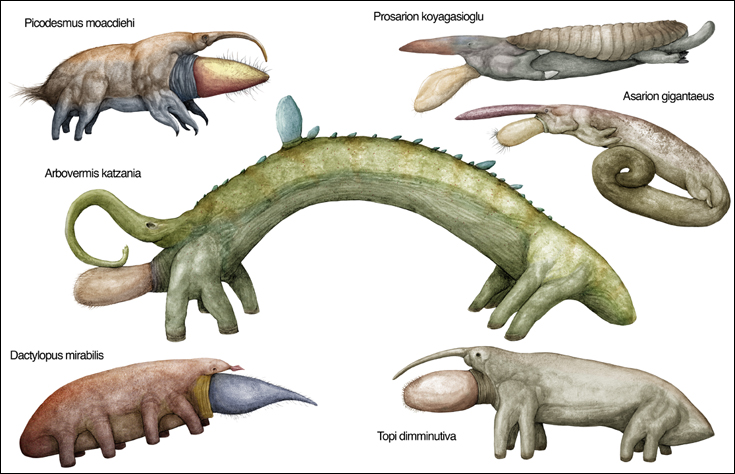Picozoans
Sometimes, it seems easy to draw Earthly analogies to Snaiadi organisms. Kahydrons can be compared to wolves and jackals, Fututors to large cats, Allotaurs to elephants and so on. Yet these are all faulty comparisons; one only needs to look underfoot to realize the truly alien nature of life on Snaiad. On no other planet have the relatives of large, terrestrial “vertebrates” become tiny, insect-like organisms like the Picozoans.
Picozoans have numerous adaptations for being tiny. During development, their bones never ossify but remain as cartilaginous sketches that sometimes disappear later on in life. As a consequence, soft and supple muscles (fiberous and hydraulic,) are the only support for their bodies. Picozoans also have no true second heads, but gap-like openings through which direct extensions of the digestive system emerge. This allows them to absorb nutrients directly from almost any source, but limits the size of what they can eat. Most importantly, most (but not all) Picozoans have an unusual, worm-like larval stage that later metamorphoses into the adult form. This exceptional lifestyle allows adults and juveniles to inhabit different niches, reducing competition and increasing fecundity.
There are tens of thousands of Picozoan species, almost equal in numbers to the various Trike lineages. Many more doubtlessly await discovery and scientific description. Due to their sheer diversity, a complete outline of their natural history would take volumes to write down. Here, we present some of the most basic and common Picozoan lineages.

Species: Prosarion koyagasioglu
Common Name: Prosarion, Nosymole.
Size: 5-7 centimeters long.
Habitat: Underground in plains around the Neomediterranean, possibly present throughout Isterna.
There are two great lineages of Picozoans, which may or may not be related. Gigantopicozoans like Prosarion and Asarion form one of these branches, which resemble conventional Snaiadi “vertebrates” more in terms of their anatomy and lifestyle. To begin with, these animals are “giants,” growing up to ten or twenty centimeters in some cases. They also retain complete legs rather than just fingers fused to their bodies, and most of their bones. Most importantly, Gigantopicozoans completely skip the bizarre larval stage of other Picozoans and reproduce through eggs that develop into regular, albeit incredibly small babies.
Prosarion is a typical Gigantopicozoan that lives more or less like a tiny mole. It uses its powerful forelimbs to dig around in soil, engulfing and eating anything it bumps in with its sensitive first head that doubles as an egg sac. Unlike many other relatives, this species seldom dwells into sprog or leaf litter and remains completely underground most of the time. Perhaps because of this, it has developed a series of armored scutes across its back.

Species: Asarion giganteus
Common Name: Giant Nosymole.
Size: 15-20 centimeters with tail.
Habitat: Undergrowth and sprogland around Pansavannah.
These animals, almost large as a person’s hand, are the titans of the Picozoan world. Most of Asarion’s behavior and biology is similar to other Gigantopicozoans’, with the marked exception of its fatty, food-storing tail and its tendency to “lurk” in holes and wait for passing victims. Observing these similarities, some researchers recently suggested affinities between Gigantopicozoans and the Chasmostomes, but recent molecular comparisons do not support these hypotheses. It is more likely that these characteristics are the result of convergent evolution rather than a true relationship.

Species: Topi dimminutiva
Common Name: Bol.
Size: 1 centimeter.
Habitat: Sprogland and beneath shrubs in the Great Vesternian Plains.
Topi is a more proper Picozoan, or an Eupicozoan; with legs reduced to hydraulic-based “fingers,” an exceptionally tiny size and a completely differentiated juvenile life stage, or a “worm.” As a worm these animals inhabit the body stalks of certain green land plants, and the adults live in sprog, eating decaying organic matter and tiny animals, including other Picozoans. Topi species all have extremely elongated first heads that are used as sensory probes. In life these creatures seem extremely active and shivery, constantly poking their “noses” and secondary heads around in a frantic search for food and mates. After a short pregnancy, the females squeeze their offspring out like bits of living toothpaste from their inflated first-head genitals.

Species: Dactylopus mirabilis
Common Name: Red object.
Size: 3-4 millimeters.
Habitat: Almost everywhere across Western Isterna and Eastern Vesterna.
Herbivorous Picozoans like Dactylopus show the extremes of leg-finger extension. In a reversal of the initial leg development in Snaiadi “vertebrates,” they have lost all surrounding muscles and supports outside their two main digits, which at two per limb function perfectly like eight tiny legs. These animals feed by extending their second-head stomachs into cuts they make in plant tubes and roots, drawing out the nutrients and water. The “worms” of this species feeds on certain Erythrophytes, which are known to be toxic. After metamorphosis they retain the toxins of their former food source and use them to defend against potential predators. Their distasteful nature is advertised by these animals’ conspicuous red-and-blue coloration.

Species: Arbovermis katzania
Common Names: Grinchworm, Green Worm.
Size: 3 centimeters, usually less.
Habitat: Limited distribution in Isternian Jungles.
Some Picozoans have evolved extremely cryptic body shapes and unusual, silhouette-breaking scales in order to defend themselves from predators. Arbovermis is one such example, spectacular, large (for an Eupicozoan) but very rare in its jungle habitat. It is known only from a handful of specimens from remote cameras and research traps. Although they have been observed feeding on small animals and certain plants, other aspects of their lives, such as their “worm” stage, remain frustratingly unknown.

Species: Picodesmus moacdiehi
Common Names: Bid, Orange Bid, Pid.
Size: 8 milimeters to 1 centimeter.
Habitat: Humid habitats and jungles along North-Eastern Vesterna.
Their successful diversification meant that the Picozoans evolved tiny parallels of every large-fauna drama on Snaiad. While most Picozoans are omnivores or herbivores, some clades have specialized exclusively for predatory lifestyles. The Bidiforms, or Bids, as they are commonly known, are one of the most widespread of predatory Picozoans. These creatures have even left their mark on Snaiadi culture with the pejorative terms “Bid” and “Pid,” which are used when referring to an irritable, annoying and cruel person.
Death to the Bids’ victims always comes with a sudden pounce. Driven by flicks of their spring-like rear pairs of finger-legs, they launch themselves onto their unwary prey. The prey, which consists mostly of other Picozoans or their “worms,” is then killed by the pincer like grasp of the two front pairs of finger-legs. It has recently been discovered that some Bidiforms also lace their pincer-legs with a form of dermal poison, but P. moacdiehi itself is not poisonous. Like almost all Bidiform Picozoans, these animals have huge eyes, proportionally among the largest in Snaiad. Picodesmus moacdiehi is named after Emile Moacdieh, an Earth-born citizen who named numerous small animals on the planet during the early years of exploration.
Copyright laws protect all intellectual property associated with Snaiad.
All artwork, concepts and names associated with this project belong to C. M. Kosemen, unless otherwise stated.
